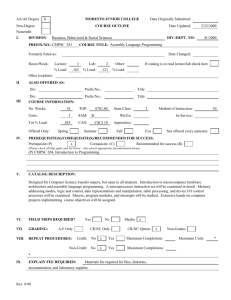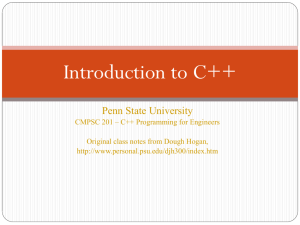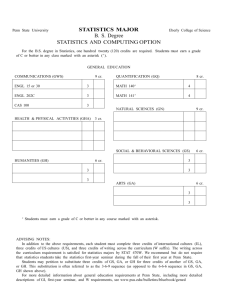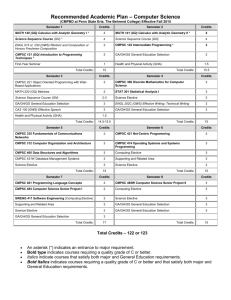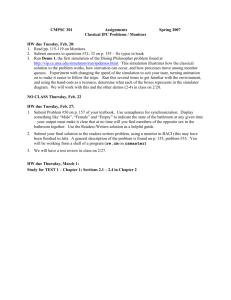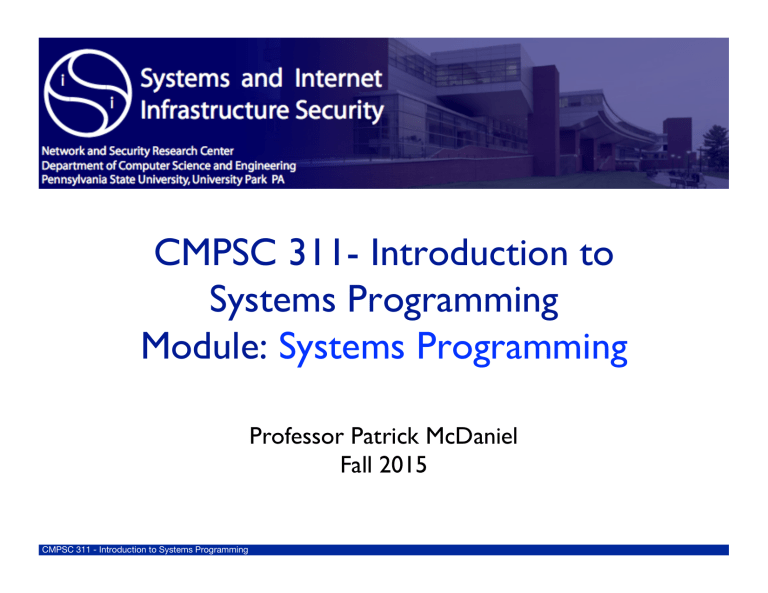
CMPSC 311- Introduction to Systems Programming Module: Systems Programming Professor Patrick McDaniel Fall 2015 CMPSC 311 - Introduction to Systems Programming WARNING • Warning: for those not in the class, there is an unusually large number of people trying to get in (4x more than any other year). I cannot make any promises that everyone will get into the class due to others dropping. CMPSC 311 - Introduction to Systems Programming Page Software Systems • A platform, application, or other structure that: ‣ is composed of multiple modules … • the system’s architecture defines the interfaces of and relationships between the modules ‣ usually is complex … • in terms of its implementation, performance, management ‣ hopefully meets some requirements … • Performance • Security • Fault tolerance • Data consistency CMPSC 311 - Introduction to Systems Programming These are properties of computer systems that people design, optimize, and test for. Some refer to the as "ilities” (pronounced "ill-it-tees") Page 3 100,000 Foot View of Systems OS / app interface (system calls) HW/SW interface (x86 + devices) C application C++ application Java application C standard library (glibc) C++ STL / boost / standard library JRE operating system hardware memory storage CPU network GPU clock audio radio peripherals CMPSC 311 - Introduction to Systems Programming Page 4 A layered view provides service to layers above client client client your system understands and relies on layers below layer below layer below ••• CMPSC 311 - Introduction to Systems Programming Page 5 A layered view more useful, portable, reliable abstractions client client client your system constrained by performance, footprint, behavior of the layers below layer below layer below ••• CMPSC 311 - Introduction to Systems Programming Page 6 Example system • Operating system ‣ a software layer that abstracts away the messy details of hardware into a useful, portable, powerful interface ‣ modules: • file system, virtual memory system, network stack, protection system, scheduling subsystem, ... • each of these is a major system of its own! ‣ design and implementation has many engineering tradeoffs • e.g., speed vs. (portability, maintainability, simplicity) CMPSC 311 - Introduction to Systems Programming Page 7 Another example system • Web server framework ‣ a software layer that abstracts away the messy details of OSs, HTTP protocols, database and storage systems to simplify building powerful, scalable Web services ‣ modules: • HTTP server, HTML template system, database storage, user authentication system, ... ‣ also has many, many tradeoffs • programmer convenience vs. performance • simplicity vs. extensibility Note: we will focus on the OS system this semester. CMPSC 311 - Introduction to Systems Programming Page 8 Systems and Layers • Layers are collections of system functions that support some abstraction to service/app above ‣ Hides the specifics of the implementation of the layer ‣ Hides the specifics of the layers below ‣ Abstraction may be provided by software or hardware ‣ Examples from the OS layer • processes • files • virtual memory CMPSC 311 - Introduction to Systems Programming Page 9 A real world abstraction ... • What does this thing do? What about this? CMPSC 311 - Introduction to Systems Programming Page 10 What makes a good abstraction? • An abstraction should match “cognitive model” of users of the system, interface, or resources “Cognitive science is concerned with understanding the processes that the brain uses to accomplish complex tasks including perceiving, learning, remembering, thinking, predicting, inference, problem solving, decision making, planning, and moving around the environment.” --Jerome Busemeyer CMPSC 311 - Introduction to Systems Programming Page How humans think (vastly simplified) • Our brain’s receive sensor data to perceive and categorize environment (pattern matching and classification) ‣ Things that are easy to assimilate (learn) are close to things we already know ‣ The simpler and more generic the object, the easier (most of the time) it is to classify • See human factors, physiology, and psychology classes .. CMPSC 311 - Introduction to Systems Programming Page A good abstraction … • Why do computers have a desktop with files, folders, trash bins, panels, switches … • … and why not streets with buildings, rooms, alleys, dump-trucks, levers, … CMPSC 311 - Introduction to Systems Programming Page In class exercise … • In groups of three to four: ‣ Desktops are outlawed by the computer police ‣ You are to come up with alternate abstractions for: • Data objects (i.e., replacements for files and directories) • Be ready to explain in 30 seconds your “environment”, what are the metaphors, and why they are appropriate given user’s cognitive models …. • Bonus for being innovative and timely CMPSC 311 - Introduction to Systems Programming Page Computer system abstractions • What are the basic abstractions that we use (and don’t even think about) for modern computer systems? CMPSC 311 - Introduction to Systems Programming Page Processes • Processes are independent programs running concurrently within the operating systems ‣ The execution abstraction provides is that it has sole control of the entire computer (a single stack and execution context) Tip: if you want to see what processes are running on your UNIX system, use the “ps” command, e.g., “ps -ax”. CMPSC 311 - Introduction to Systems Programming Page 16 Files • A file is an abstraction of a read only, write only, or ready/write data object. ‣ A data file is a collection of data on some media • often on secondary storage (hard disk) ‣ Files can be much more: in UNIX nearly everything is a file • Devices like printers, USB buses, disks, etc. • System services like sources of randomness (RNG) • Terminal (user input/out devices) Tip: /dev directory of UNIX contains real and virtual devices, e.g., “ls /dev”. CMPSC 311 - Introduction to Systems Programming Page 17 Virtual Memory • The virtual memory abstraction provides control over an imaginary address space ‣ Has a virtual address space which is unique to the process ‣ The OS/hardware work together to map the address on to ... • Physical memory addresses • Addresses on disk (swap space) ‣ Advantages • Avoids interference from other processes • swap allows more memory use than physically available CMPSC 311 - Introduction to Systems Programming Page 18 Byte-Oriented Memory Organization ••• • Programs Refer to Virtual Addresses ‣ Conceptually very large array of bytes ‣ Actually implemented with hierarchy of different memory types ‣ System provides address space private to particular “process” • Program being executed • Program can clobber its own data, but not that of others • Compiler + Run-Time System Control Allocation ‣ Where different program objects should be stored ‣ All allocation within single virtual address space CMPSC 311 - Introduction to Systems Programming Page 19 Machine Words • Machine Has “Word Size” ‣ Nominal size of integer-valued data Including addresses ‣ Many traditional machines use 32 bits (4 bytes) words • Limits addresses to 4GB • Becoming too small for memory-intensive applications ‣ Recent systems use 64 bits (8 bytes) words ‣ Potential address space ≈ 1.8 X 1019 bytes ‣ x86-64 machines support 48-bit addresses: 256 Terabytes • Machines support multiple data formats ‣ Fractions or multiples of word size ‣ Always integral number of bytes CMPSC 311 - Introduction to Systems Programming Page 20 Word-Oriented Memory Organization • Addresses Specify Byte Locations ‣ Address of first byte in word ‣ Addresses of successive words differ by 4 (32-bit) or 8 (64-bit) 32-bit Words Addr = ?? 0000 Addr = ?? 0004 Addr = ?? 0008 Addr = ?? 0012 CMPSC 311 - Introduction to Systems Programming 64-bit Words Addr = ?? 0000 Addr = ?? 0008 Bytes Addr. 0000 0001 0002 0003 0004 0005 0006 0007 0008 0009 0010 0011 0012 0013 0014 0015 Page 21 APIs • An Applications Programmer Interface is a set of methods (functions) that is used to manipulate an abstraction ‣ This is the “library” of calls to use the abstraction ‣ Some are easy (e.g., printf) ‣ Some are more complex (e.g., network sockets) ‣ Mastering systems programming is the art and science of mastering the APIs including: • How they are used? • What are the performance characteristics? • What are the resource uses? • What are their limitations CMPSC 311 - Introduction to Systems Programming Page Example: Java Input/Output • Set of abstractions that allow for different kinds of input and output ‣ Streams … ‣ Tokenizers …. ‣ Readers … ‣ Writers … • Professional Java programmers know when and how to uses these to achieve their goals CMPSC 311 - Introduction to Systems Programming Page Systems programming • The programming skills, engineering discipline, and knowledge you need to build a system using these abstractions: ‣ programming: C (the abstraction for ISA) ‣ discipline: testing, debugging, performance analysis ‣ knowledge: long list of interesting topics • concurrency, OS interfaces and semantics, techniques for consistent data management, algorithms, distributed systems, ... • most important: deep understanding of the “layer below” CMPSC 311 - Introduction to Systems Programming Page 24 Programming languages • Assembly language / machine code ‣ (approximately) directly executed by hardware ‣ tied to a specific machine architecture, not portable ‣ no notion of structure, few programmer conveniences ‣ possible to write really, really fast code • Compilation of a programming language results in executable code to be run by hardware. ‣ gcc (C compiler) produces target machine executable code (ISA) ‣ javac (Java compiler) produces Java Virtual Machine executable code CMPSC 311 - Introduction to Systems Programming Page 25 Programming languages • Structured but low-level languages (C, C++) ‣ hides some architectural details, is kind of portable, has a few useful abstractions, like types, arrays, procedures, objects ‣ permits (forces?) programmer to handle low-level details like memory management, locks, threads ‣ low-level enough to be fast and to give the programmer control over resources • double-edged sword: low-level enough to be complex, error- prone • shield: engineering discipline CMPSC 311 - Introduction to Systems Programming Page 26 Programming languages • High-level languages (Python, Ruby, JavaScript, ...) ‣ focus on productivity and usability over performance ‣ powerful abstractions shield you from low-level gritty details (bounded arrays, garbage collection, rich libraries, ...) ‣ usually interpreted, translated, or compiled via an intermediate representation ‣ slower (by 1.2x-10x), less control CMPSC 311 - Introduction to Systems Programming Page 27 Discipline • Cultivate good habits, encourage clean code ‣ coding style conventions ‣ unit testing, code coverage testing, regression testing ‣ documentation (code comments!, design docs) ‣ code reviews • Will take you a lifetime to learn ‣ but oh-so-important, especially for systems code • avoid write-once, read-never code CMPSC 311 - Introduction to Systems Programming Page 28 Knowledge • Tools ‣ gcc, gdb, g++, objdump, nm, gcov/lcov, valgrind, IDEs, race detectors, model checkers, ... • Lower-level systems ‣ UNIX system call API, relational databases, map/reduce, Django, ... • Systems foundations ‣ transactions, two-phase commit, consensus, handles, virtualization, cache coherence, applied crypto, ... CMPSC 311 - Introduction to Systems Programming Page 29
